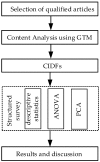Exploring the Driving Factors of Construction Industrialization Development in China
- PMID: 29510507
- PMCID: PMC5876987
- DOI: 10.3390/ijerph15030442
Exploring the Driving Factors of Construction Industrialization Development in China
Abstract
Construction industrialization (CI) has been adopted worldwide because of its potential benefits. However, current research shows the incentives for adopting CI may differ in different regions. While the promotion of CI in China is still at the initial stage, a systematical analysis of the driving factors would help decision makers get a comprehensive understanding of CI development and select proper strategies to promote CI. This research combines qualitative and quantitative methods to explore the construction industrialization driving factors (CIDFs) in China. The grounded theory method (GTM) was employed to explore CI concepts among 182 CI-related articles published in 10 top-tier journals from 2000 to 2017. A total of 15 CIDFs were identified, including one suggested by professionals during a pre-test questionnaire survey. The analysis showed that the development of CI in China is pushed by macrodevelopment and pulled by the government and is also a self-driven process. The major driving factors for CI adoption in China are the transformation and upgrade of the conventional construction industry and the solution of development dilemmas. Our study also suggests that pilot programs are, currently, the most effective method to promote CI in China and to accumulate experience so to gain recognition by the society. This research is also of value for CI promotion in other developing countries.
Keywords: China; construction industrialization (CI); content analysis; driving factors; grounded theory method; pull and push; questionnaire survey.
Conflict of interest statement
The authors declare no conflict of interest.
Figures
Similar articles
-
Exploring Precursors of Construction Accidents in China: A Grounded Theory Approach.Int J Environ Res Public Health. 2021 Jan 7;18(2):410. doi: 10.3390/ijerph18020410. Int J Environ Res Public Health. 2021. PMID: 33430202 Free PMC article.
-
Emission drivers of cities at different industrialization phases in China.J Environ Manage. 2019 Nov 15;250:109494. doi: 10.1016/j.jenvman.2019.109494. Epub 2019 Sep 9. J Environ Manage. 2019. PMID: 31514002
-
Improving Construction Industrialization Practices from a Socio-Technical System Perspective: A Hong Kong Case.Int J Environ Res Public Health. 2021 Aug 26;18(17):9017. doi: 10.3390/ijerph18179017. Int J Environ Res Public Health. 2021. PMID: 34501607 Free PMC article.
-
A Framework of Industrialized Building Assessment in China Based on the Structural Equation Model.Int J Environ Res Public Health. 2018 Aug 8;15(8):1687. doi: 10.3390/ijerph15081687. Int J Environ Res Public Health. 2018. PMID: 30096790 Free PMC article. Review.
-
Footbinding, Industrialization, and Evolutionary Explanation : An Empirical Illustration of Niche Construction and Social Inheritance.Hum Nat. 2016 Dec;27(4):501-532. doi: 10.1007/s12110-016-9268-5. Hum Nat. 2016. PMID: 27778301 Review.
Cited by
-
Risk factors of neurologic deficit after thoracolumbar burst fracture.Front Neurol. 2025 May 12;16:1542622. doi: 10.3389/fneur.2025.1542622. eCollection 2025. Front Neurol. 2025. PMID: 40421139 Free PMC article.
-
Modeling Adoption Behavior of Prefabricated Building with Multiagent Interaction: System Dynamics Analysis Based on Data of Jiangsu Province.Comput Intell Neurosci. 2021 Nov 30;2021:3652706. doi: 10.1155/2021/3652706. eCollection 2021. Comput Intell Neurosci. 2021. PMID: 34887914 Free PMC article.
-
Evolutionary Game Research on Green Construction Considering Consumers' Preference under Government Supervision.Int J Environ Res Public Health. 2022 Dec 13;19(24):16743. doi: 10.3390/ijerph192416743. Int J Environ Res Public Health. 2022. PMID: 36554623 Free PMC article.
-
Efficacy of anterior-posterior decompression on thoracolumbar spine fracture with spinal cord injury and analysis of risk factors for postoperative deep vein thrombosis.Am J Transl Res. 2022 Jun 15;14(6):4033-4041. eCollection 2022. Am J Transl Res. 2022. PMID: 35836875 Free PMC article.
-
Evaluation of Characteristics and Building Applications of Multi-Recycled Concrete Aggregates from Precast Concrete Rejects.Materials (Basel). 2022 Aug 19;15(16):5714. doi: 10.3390/ma15165714. Materials (Basel). 2022. PMID: 36013850 Free PMC article.
References
-
- Mao C., Shen Q., Pan W., Ye K. Major barriers to off-site construction: The developers’ perspective in China. J. Manag. Eng. 2015;31:04014043. doi: 10.1061/(ASCE)ME.1943-5479.0000246. - DOI
-
- Gibb A.G.F. Standardization and pre-assembly-distinguishing myth from reality using case study research. Constr. Manag. Econ. 2001;19:307–315. doi: 10.1080/01446190010020435. - DOI
-
- Zhang X., Skitmore M., Peng Y. Exploring the challenges to industrialized residential building in China. Habitat Int. 2014;41:176–184. doi: 10.1016/j.habitatint.2013.08.005. - DOI
-
- Gibb A., Isack F. Re-engineering through pre-assembly: Client expectations and drivers. Build. Res. Inf. 2003;31:146–160. doi: 10.1080/09613210302000. - DOI
-
- Jaillon L., Poon C.S. The evolution of prefabricated residential building systems in Hong Kong: A review of the public and the private sector. Autom. Constr. 2009;18:239–248. doi: 10.1016/j.autcon.2008.09.002. - DOI
Publication types
MeSH terms
LinkOut - more resources
Full Text Sources
Other Literature Sources



